 |
|
|
Literature Discussion - Lit-Talk.com
Human Personality
By Evans Kinyua (Kenya)
Click here if you'd like to exchange critiques
This manuscript proposes that human personality can be generally classified by shapes, such as squares, circles and triangles. Squares symbolize those who adhere to facts and beliefs. Circles represent those who are outgoing and flexible, and triangles stand for those who are indecisive and fluctuate between square and circle. The author raises examples for each shape and systemically analyzes the potential outcomes that result from the interaction between personality shapes in a marriage or in the workplace.
This is a very intriguing article that will be interesting to a broad range of audiences from different genders, cultures, and occupations. It would be more reader-friendly if the author used more appropriate adjectives; particularly, when each personality shape was described. For example, use “persistent” instead of “stubborn”. The conclusion was a good idea: to state that the goal of this article is not to determine which personality is better over the other, but rather to objectively describe their implications and interactions.
Human Personality by Evans Kinyua (kinyua@globalteamltd.com)
INTRODUCTION.
Human Personality Shape Hypothesis
Many studies and research have been done to classify human beings and human behavior using physical attributes and temperament. Such studies have shed light on what differentiates the physiological appearance as well as the behavior of different people. Often these studies have grouped people in certain specific categories, where one is either or, or a mixture of the various attributes.
I would like to add an additional study to those already done, and classify human beings according to the following characteristics or innate being.
These classifications, I believe, will shed some light on how human beings relate to each other, as friends, siblings, spouses, and relatives. I am not a scientist, but a keen observer of human behavior. I have no claim to being an authority, and this study is not meant as a cast-in-stone research backed by statistical data. However, I believe that it will help people understand others better, and perhaps even save much heartache for those who read it. I call it ‘the Human Personality Shape Hypothesis’
CLASSIFICATIONS.
- THE SQUARE
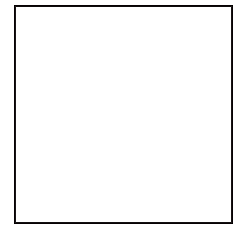
The square refers to individuals who, by their nature and not by choice, are inflexible, dominating and conservative in thought and belief. These people are likely to be introverted and are fixated on the ideas that inform their world view, and are unlikely to be receptive to new ideas.. Other people probably see them as anti-social, they do more listening than talking. They are very good at hiding their emotions and opinions, especially about things that are important.To the squares, their own needs come before other’s needs. They do not forgive easily, and when they do, it is rarely from deep down.
This rigidity is what compares them to a square, all straight lines and sharp corners. Thus they are very predictable. They are risk averse, and will not take chances that are not based on facts, and prefer to remain firmly anchored on the ground.
Other people most probably consider them strong individuals. They do not know humility, and usually have big egos. Squares are most likely to be scientists, since they are most comfortable with facts, numbers and formulae that leave no room for alternative thinking. They are likely to be unpopular people, given to dictatorial tendencies.
Examples of box personalities in the world include:
1. Robert Mugabe
2. George Bush
3. Paul Kagame
4. Raila Odinga
5. Hugo Chavez
6. Fidel Castro
7. Margaret Thatcher
8. Martha Karua
9. Thabo Mbeki
10. John Garang
11. Vladimir Putin
- ROBERT MUGABE.
Comrade Robert Mugabe rose to the helm of Zimbabwe riding on the shoulders of his freedom fighters. He was referred to as an African revolutionary and admired all over the continent.
Over the years it was well known that Mugabe was highly opinionated and unwavering in conviction, qualities that endeared him as an African firebrand and a champion of the rights of African people.
That admiration turned first to indignation, disbelief and finally into loathing by the same former admirers when he persistently implemented the nationalization of white owned farms and dished them out to his cronies under the guise of resettling landless Zimbabweans. That inflexibility and unwillingness to listen to advice has brought Zimbabwe to her knees. He has clobbered the opposition almost to submission. At the time of writing, Mugabe has completely refused a power sharing arrangement with the opposition. When the opposition leader Morgan Tsvangirai declined to contest a run off, Mugabe contested alone, trashing volumes of advice from the international community.
Mugabe is one of the best examples of a square personality.
- GEORGE BUSH.
Former United States president George Bush fits snugly the euphemism ‘maverick president’. His was a presidency where his word was law, the view of others of little consequence. His Iraq misadventure was ill advised, underscored by the lukewarm support the he received from Europe, a region of traditional allies. All except UK, led by Tony Blair. That particular relationship was typical of the square swallowing the circle.
It is instructive that a senior circle in his government, retired general Collins Powel, jettisoned ship and resigned, due to the strong arm tactics of Mr. Bush that he found unpalatable. That circle refused to be controlled by the square.
It will also be remembered that president Bush strongly opposed the Kyoto Protocol on the issue of climate change while most of the world advocated of the principles of the protocol.
President Bush completed the last days of his second term as the most unpopular US president ever, according to polls.
The unpopularity of this particular square gave Barrack Obama, the circle successor, a fairly easy campaign. The people of the United States of America were not ready for another square
Presidency. Incidentally, John McCain, Obama’s opponent, is a veritable square. No wonder he was defeated by a mile.
- PAUL KAGAME.
Rwandan President Paul Kagame portrays all the characteristics of a square personality. His conviction is total, such as when a journalist asked him in an interview what he would do if he caught up with the Hutu dissidents hiding in Congo. “we’ll kill them,” he calmly answered, undisturbed by the opinion of the journalist and the audience. Taken aback by the response, the journalist was unsure how to pursue that line of questioning any further.
Kagame would probably have been a typical square type African dictator (or may become one, time will tell], had he not inherited a very unique situation after the horrors of the Rwanda genocide.
The need for the country’s reconciliation called for tempering of his square tendencies, which he is doing with success but, I proffer, with great amount of personal restraint. He is a square who mixes with a number of circle tendencies. The style seems to be great for Rwanda. Kagame is a benevolent dictator, if you will. That is what you get when you cross a square president with circle traits. The difference with Daniel Moi is that he is mixing the two deliberately. He knows that he is a square but he wishes to borrow from the circle traits what he needs to make the country better.
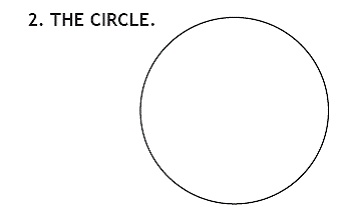
These are individuals who are the direct opposite of squares. They are outgoing, flexible,
liberal and willing to accommodate and experiment with new ideas. They consider all points of view, and are willing to change their minds if they believe in the new thinking. They are social, and wish to belong to the team nature rather than lead it. They would rather lead the team by popular election rather than own initiative or force of personality.
However they have equally strong beliefs as the box, but would rather convince the others to follow them, rather than force them, or leave the group if their views are not taken just like the square would. The circles are often mistaken as soft, but their apparent willingness to accommodate others, a strong conscience and avoidance of aggression and disagreement probably hides their strong values. They are likely to be highly passionate, mostly in artistic endeavors.
The circles have a high degree of humility and may consider the needs of others before their own. They are unpredictable since they react to situations as those situations unfold.
They easily forgive, and when they do it is sincere and from the bottom of their hearts. They are risk takers and enjoy life to the fullest, sometimes they have a penchant for going overboard. They don’t just enjoy life, they soar.
Most of the world’s real and committed revolutionaries were most likely to have been circles. In addition, they are probably unreserved romantics who clearly see the goal rather than the obstacles.
Examples of prominent circle personalities:-
1. Nelson Mandela
2. Barrack Obama
3. Bob Marley
4. Wangari Maathai
5. Mahatma Gandhi
6. Che Guevara
7. Ronald Reagan
8. Martin Luther King
9. Bill Clinton
10. Julius Nyerere
11. Ernest Hemmingway
12. Tony Blair
13. Muammar Gadaffi
- NELSON MANDELA.
It is undisputable that Nelson Mandela is the most famous icon of the circle personality in the world in the 20th century. After 27 years of incarceration, a number of them in solitary confinement and the rest doing back breaking work smashing stones, the man agreed to share power with his former tormentors. In other words, he was willing to sit on the same table with them, consult them and transact government business with them for the period of his presidency. He could have easily insisted on an absolute government based on popular vote, which he would have easily won under the African National Congress (ANC). What a sacrifice! Yes, only a circle could so easily concede such ground from such a strong position.
- BARRACK OBAMA.
During his campaign, the president of the United States incessantly broadcasted the message of inclusiveness. If anything, this is the character that clearly separated his square predecessor from his circle self. Everything he said started with the word ‘we’, which became a powerful theme in that campaign.
Moreover, the message of inclusiveness was made even more powerful when he acknowledged his win to the republicans, the constituency that had not voted for him. President Obama explained that he will be the republican voters’ president too, and will be listening to their views and needs as well. A square character winning with such a landslide would have most likely have ignored the opposing party.
President Obama’s forays into K’ogelo to find and identify his family even when he had been elected Senator, is astounding. The picture that we saw of him helping his grandmother carry and sell cassava at the market point to his circle characteristics of humility and respect for others.
A circle is a social and likable person, and it is no wonder that president Obama was admired around the world in the build up to and after the elections.
I believe that Obama’s is a very consultative presidency, typical of a circle.
3. BOB MARLEY
He was voted the man of the century by the British Broadcasting Corporation (BBC) and his song “one love” was played at the stroke of midnight on 31st December, 1999.
This very true circle created music that reverberated with revolutionary lyrics. Almost every song advocated for the rights of the downtrodden everywhere in the world, and the black race in particular. He denounced violence and never advocated for his audience to use it to fight for their rights. Bob Marley made music that grew virtually into a way of life, a cult and a belief system for millions around the world, transcending race.
Only a great circle can portray such artistic genius. His lifestyle of uninhibited freedom (music, smoking weed, many women], is typical of a circle who does not relish control. It is a pity that he died so young at 36.
- THE TRIANGLE

These are the individuals who fall between the square and the circle. They are halfway between a square and a circle, and may lean one way or another depending on the circumstances. A triangle can be termed as a cross between a square and a circle.
The traits that characterize their personality reflect this confusion. They are not committed to beliefs and ideas like the squares and circles are. They will therefore not complete tasks that they set for themselves, along the way they will abandon them and start new ones. They are confused and for this reason they are rarely successful. Due to this seesaw nature, they are bound to make a fool of themselves.
Triangles are very difficult to identify because they prevaricate and swing both ways, one time behaving like a square and the other like a circle. Usually energetic but rudderless, without direction.
Examples of famous triangle personalities:-
1. Idi Amin Dada
2. Daniel Arap Moi
- IDI AMIN DADA
Idi Amin Dada is the illiterate soldier who took leadership of Uganda after overthrowing president Milton Obote. The famous buffoon president had a Jekyll and Hyde split personality, completely confused even to his closest confidantes. Many are those who misread his moods and intentions, and ended up very dead ?. Idi Amin was typical of the triangle personality, one minute dictatorial, self-assured, stubborn and proud, the next minute indecisive, obsequious and almost
groveling to be liked.
His life was a strange tale of wishful heroism and misguided populism. Dreams of imperialism and crowning himself conqueror of the British Empire(no pun], repeating a wedding to one of his many wives due to what he described as ‘public demand’, attempting to annex a large swathe of Kenyan territory, handing all Asian owned business to his friends as freebies after kicking the owners out of the country,etc.
2 DANIEL ARAP MOI
In contrast to the popular belief, former President Daniel Moi was not a square personality. The strong armed and dictatorial tendencies that we saw in him were not the traits of a true and committed square personality. Neither his prolific church attendance nor his stated love for women and children were the traits of a true committed circle personality. Moi was a triangle, who was unsure which way to go and lacking a dominant personality.. He oscillated between the two depending on the circumstances.
Prior to 1982, all we saw of Moi were circle traits. After the attempted coup, he adopted certain square tendencies, including detention without trial, physical torture of perceived and real dissenters, and, it is alleged, condoning or even abetting violence towards the opposition.
Yet all the while he would attend church without fail on Sundays (preaching water and drinking wine?), take tea in a kiosk (attempting at being social and likable?) and buy vegetables from roadside vendors. Meanwhile some hapless opposition figure is getting striped naked and left in a cell full of water in Nyayo House. It is a veritable contradiction.He let his cronies steal anything and everything within sight, pauperizing the same women and children he professed to love. Is it another contradiction?
It is said that he would consult others, listen to their views, as he nodded sagely, only to do the opposite during the 1.00p.m news. Stories are told by Ministers who enjoyed tea with him in the morning and were sacked through the radio in the afternoon. Why did he pretend to consult and then turn around and disregard those views? Why did he listen to them at all?
Former president Moi was a triangle, suspended between a square and a circle. It is no wonder the country was in ruins and confusion by the time he relinquished power.
PART 2
HOW OUR SHAPES DEFINE OUR RELATIONSHIPS IN MARRIAGE AND FRIENDSHIPS.
The nature of life demands that human beings must interact. As they say, man is a social animal. Human beings cannot live solitary lives, in isolation like some animals do. They will have friends, spouses, brothers, children, sisters, uncles, aunts, neighbors, business partners, employers and a host of other necessary relationships. Among these,marriage that is the most intimate , the longest and the one where we spend the greatest amount of time with the other person. How do shapes interact and therefore influence the kind of relationship that we will have?
- THE SQAURE AND THE CIRCLE.
- Square controls the circle.

Where the square is paired with the circle in marriage, the most likely outcome is that the square will control the circle. Being rigid and uncompromising in approach, the square will strive to put a straight jacket on the ideas of the circle, who probably often has crazy ways that upset the strong inhibitions of the square. The circle, used to freedom of thought and experimentation, feels very confined and suffocated in this environment. The circle will sometimes rebel, which annoys the square tremendously.
The square will strive to control almost all aspects of the circle, including time, where he or she goes and what he or she does. The circle will try as much as possible to live by those parameters, not because he or she believes in the reasoning or enjoys being in that situation, but to avoid the conflict. It is the circle who will do all the compromising.
Although the circle is flexible and forgiving, this does not mean that the square does not love the circle. On the contrary, he or she may be so deeply in love, fuelling the need to control, and will never notice how stifling the arrangement is as far as the circle is concerned. If the circle is the wife, the union is likely to endure since a woman is more willing to submit to control than the man. If, on the other hand, the circle is the husband, the wife, being the square, will not understand her husband’s circle tendencies that appear every once in a while. His lack of any wish to control her and let her exercise her desire in most situations may cause her to think that he does not love her. But the circle defines love as an intimate and passionate relationship, rather than one governed by rules, edicts, dictates and barbed wire fences.
- Circle controls the square.

This is an impossible situation which rarely, if ever, occurs. In this scenario, the circle controls the square. But by his/her very nature, the circle never harbors any desire to control other people. On the other hand, the square is inflexible, and by their nature, cannot be controlled.
Whenever a square and a circle are paired, and there is no mutual compromise, it is always the circle who will be controlled by the square, not as above where the circle controls the square.
- Compromise- most common relationship.

When people are wooing each other, and finally get married, their personalities are the last thing on their minds. Unless there is a glaring attribute that one doesn’t like about the other, in which case there will be no wedding. Therefore people pair up with no regard to personality shapes of their spouse to be, which is natural anyway because both are normal people without any discernable behavioral problems. However in due course their differences are bound to start influencing how they relate to each other.
In any case, there are many attributes of the square that attract the circle, perhaps his adherence to rules and his predictability. On the other hand, the square may be attracted to the circle’s dare-devil antics, creativity, openness to his/her ideas; the square will feel the circle is the best mate. Until they get married, these traits become no longer the attractive but the source of conflict. They must strive to accommodate each other.
This is therefore the most common type of relationship, where each partner cedes some elements and attributes of themselves for the sake of harmony. The compromise must be a continuous process for as long as the two are together. Trouble starts when one starts to expect the other to cede more or when times of pressure and stress occur, as they will in our imperfect world. For the relationship to succeed, each must understand the differences in the other and continuous, gentle conversation to fuse the different points in approach. An aggressive approach to these points will only widen them.
- PERFECT MATCHES
(a) Square and square
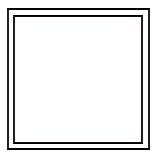
This is a situation where two squares are paired in a relationship. Though not as common as the compromise situation of the square and circle, it nevertheless occurs. The two squares are likely to see eye to eye on most issues, and adhere to the rigidity and inflexibility typical of the square personality by mutual consent. In most cases the relationship will be calm and will proceed with few bumps. The areas required for compromise are few. But if there is a disagreement it can turn nasty and violent because both are uncompromising. If there are a number of areas of disagreement, the two cannot coexist and will need to separate, sometimes violently.
(b) The circle and the circle.

These are two social, creative, flexible, happy- go- lucky people. Both are flexible and can accommodate each other’s different points of view. They are able to forgive each other and forget, genuinely with no baggage left, and go on with their lives. There might be disagreements every so often but these are quickly ironed out and the relationship gets back on track. The couple is happy most of the time, genuinely happy with no restrictions. But this lack of control could have negative repercussions, since both can go overboard at times. Otherwise it would be a perfect life.
- THE TRIANGLE.
- The triangle and the Square- the square controls the triangle
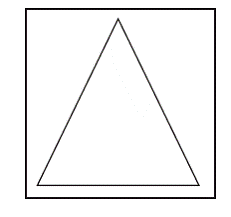
The square takes control of the triangle. The dominating character of the square gives direction to the confusing triangle. If the square is the wife, she straightens out the confusion of the husband and vice versa. The triangle’s energy is turned to productive purpose committed to one direction and stated tasks and goals.
- The circle controls the triangle.
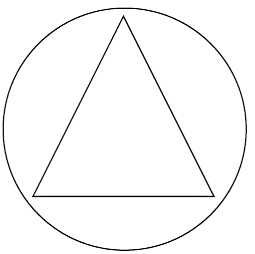
The circle takes control of the triangle. As said before, this scenario is unlikely since the circle is not pre-disposed to control any individual. However, this may occur if the triangle appreciates the commitment to a course shown by the circle. If the triangle does not voluntarily appreciate that initiative, the circle, will not try to impose his or her views and may submit to the confusion of the triangle (who has some square tendencies).
- Triangle controls the square- unlikely.
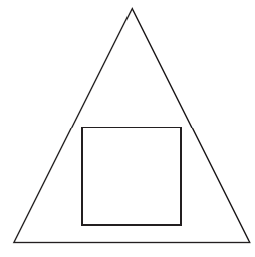
This scenario pre-supposes that the triangle swallows the square. Which is impossible since the square is the alpha being with the inbuilt tendency to control.
- Triangle swallows the circle.
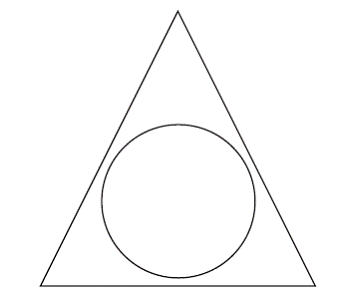
This is a very possible combination. The square half of the triangle personality may be able to swallow the circle. However, the relationship may not last due to the indecisiveness of the triangle, and the fact that the circle may not accept the square tendencies of the triangle when they do occur. The circle will be very frustrated by the chameleon like behavior of the triangle. But the circle may endure for a while, since he/she has a capacity for flexibility and humility. This relationship is likely to be chaotic and unstable.
- Triangle and triangle- total chaos!

The triangle paired with another triangle is a recipe for total disaster. Confusion reigns, and none is able to offer stability and clear direction. There is no success in such a union.
- Triangle compromises with the square.
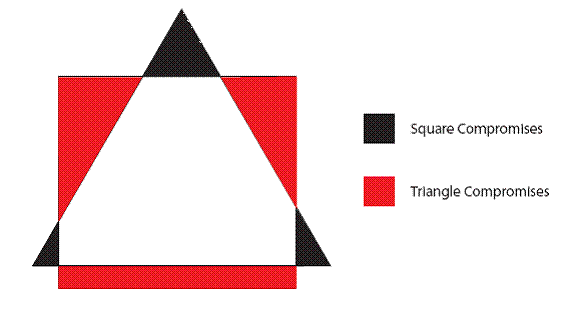
Triangle compromises with the square personality. Although possible, it is unlikely for the square to accept compromise to any significant degree for the triangle’s confused reactions. Since the square is never confused, he/she has strong and fixed convictions. The square may win over the triangle by strengthening the square half of his /her personality, and smothering the circle aspects of his/her. The triangle is always confused anyway, and will probably appreciate the guidance.
- Triangle compromises with the circle.
Converse to (e), the circle could try to amplify the circle aspects of the triangle and smother the square tendencies, but without force, which is typical circle behavior. As in (e), the triangle will probably appreciate the leadership provided by the circle, and perhaps lean more to his or her circle tendencies at the expense of the square characteristics. On the other hand, the circle may be willing to live with some of the square tendencies of the triangle.
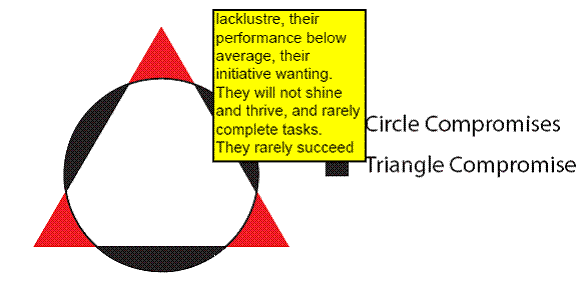
PART THREE
BEHAVIOR AT THE WORKPLACE.
- THE SQUARE.
The square is definitely NOT a team player. He is likely to be a lone ranger. Do not put the square to head a project, in which he/she is expected to work within a team. The square is likely to disregard the views of the other members of the team. Feeling ignored, the other members of the team may affect a moratorium on their input, meaning that the project may miss out some important input. The square may end up doing virtually all the work alone.
For the same reason, the square is not suited for leadership positions. He/she is primarily a worker, a functionary, possibly very effective in delivering results. But the lack of team spirit, inflexibility and lack of spontaneity means he/she is a stickler to the rules and cannot easily adapt to fast changing situations. You can say that he/she will be short on initiative.
But in the military and similar environments, which call for rigid and unquestioning discipline, the square will thrive as the leader. That is why most of the world’s military leaders have been squares.
Squares are likely to excel in the physical sciences, such as engineering, mathematics and chemistry, fields that are long on facts and figures and short on the human element.
There is such a thing as an extreme box. Such a person should never be put in a team environment.
- THE CIRCLE.
The circle is that nice guy who interacts with the other members of the team. If he/she is the team leader, he/she will motivate team members to participate in the project. The results of the task will be well-rounded, with input from all.
The circle is creative, and feels restrained by too many rules and regulations. He/she is creative, and likely to find solutions in changing circumstances. The circle is also likely to bend or even break rules in the process of performing duties.
The circle’s participatory style makes him/her the best person to lead, as this encourages all others to bring in valuable input.
Circles are likely to be in socially related fields such as business, teaching and community work. Extreme circles are not good as team leaders, since they will create a totally laissez faire environment, leading to free for all anarchy within the team.
3. THE TRIANGLE.
Most of the poor performers in the organization are likely to be triangles. They are neither functionaries like the boxes, nor are they creatives like the circles. They are lacklustre, their
performance below average, their initiative wanting. They will not shine and thrive, and rarely complete tasks. They rarely succeed in the world, rarely get promotions and are likely to be found in the same position and the same desk for many years.
CHAPTER 4
HUMAN PERSONALITY SHAPE CONDITIONING BY GENDER AND CULTURE
As previously stated, the human personality shapes described not to discriminate gender differences. There are probably as many men as there are women who exhibit either personality shape. However, there is the element of cultural and social conditioning which tends to skew gender distribution among the various personality shapes. For instance, in the western world where issues of universal suffrage, human rights, civil agitation and democracy are well entrenched, the roles of the sexes overlap. This has tended to blur the differences between the traditional roles of the sexes. For instance, the men will take turns to look after the baby, change diapers and cook meals, actions that are anathema to the African male. Africa is a predominantly patriarchal society where the man is considered the absolute head of the family, the true alpha male, and is expected to behave as such, thereby unnaturally amplifying square tendencies of control, inflexibility and non-compromise. A circle male who does not cultivate square characteristics will be considered a wimp and risks losing respect among the menfolk. Conversely, the women tend to minimize portraying those square tendencies and amplify the circle ones like agreement, sensitivity and equality. It would sound strange to a westerner that some African wives actually provoke beating by their husbands so that they can feel more feminine! This may explain why there are far more numerous divorces and tumult in western marriages than they are in Africa and Asia. It would also explain why there is so much spousal abuse and battering in Africa.
The society and the law forces the square in the west to temper his or her strong square attributes, which is not the case in Africa. On the contrary, the circle man in Africa is forced by social values to adopt square tendencies.
However, the situation is changing in Africa. With globalization (read westernization), the rise of civil society and gender equality movements and education, the human personality shapes are becoming blurred in Africa as well. It is no wonder that divorce rates are climbing on the continent.
Perhaps God, in His wisdom, created the squares, circles and even triangles to remain as they are, as opposed to human beings imposing behavior that is alien to the person, which causes inordinate stress to the individual.
CONCLUSION
This book does not in any way suggest that either personality shape is good or bad. It simply tries to describe them for the way they are. In fact it suggests that neither group is to blame for who they are, because that is the way they were born, that is the way they are wired. But only by such understanding can we learn to understand others and live with them.